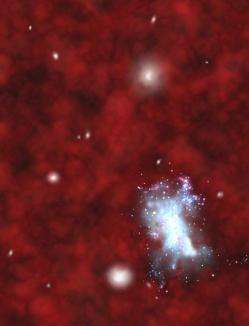When Dwarfs Gave Way to Giants

The first galaxies were small - about 10,000 times less massive than the Milky Way. Billions of years ago, those mini-furnaces forged a multitude of hot, massive stars. In the process, they sowed the seeds for their own destruction by bathing the universe in ultraviolet radiation. According to theory, that radiation shut off further dwarf galaxy formation by both ionizing and heating surrounding hydrogen gas. Now, astronomers Stuart Wyithe (University of Melbourne) and Avi Loeb (Harvard-Smithsonian Center for Astrophysics) are presenting direct evidence in support of this theory.
Wyithe and Loeb showed that fewer, larger galaxies, rather than more numerous, smaller galaxies, dominated the billion-year-old universe. Dwarf galaxy formation essentially shut off only a few hundred million years after the Big Bang.
"The first dwarf galaxies sabotaged their own growth and that of their siblings," says Loeb. "This was theoretically expected, but we identified the first observational evidence for the self-destructive behavior of early galaxies."
Their research is being reported in the May 18, 2006 issue of Nature.
Nearly 14 billion years ago, the Big Bang filled the universe with hot matter in the form of electrons and hydrogen and helium ions. As space expanded and cooled, electrons and ions combined to form neutral atoms. Those atoms efficiently absorbed light, yielding a pervasive dark fog throughout space. Astronomers have dubbed this era the "Dark Ages."
The first generation of stars began clearing that fog by bathing the universe in ultraviolet radiation. UV radiation splits atoms into negatively charged electrons and positively charged ions in a process called ionization. Since the Big Bang created an ionized universe that later became neutral, this second phase of ionization by stars is known as the "epoch of reionization." It took place in the first few hundred million years of existence.
"We want to study this time period because that's when the primordial soup evolved into the rich zoo of objects we now see," said Loeb.
During this key epoch in the history of the universe, gas was not only ionized, but also heated. While cool gas easily clumps together to form stars and galaxies, hot gas refuses to be constrained. The hotter the gas, the more massive a galactic "seed" must be to attract enough matter to become a galaxy.
Before the epoch of reionization, galaxies containing only 100 million solar masses of material could form easily. After the epoch of reionization, galaxies required more than 10 billion solar masses of material to be assembled.
To determine typical galaxy masses, Wyithe and Loeb looked at light from quasars - powerful light sources visible across vast distances. The light from the farthest known quasars left them nearly 13 billion years ago, when the universe was a fraction of its present age. Quasar light is absorbed by intervening clouds of hydrogen associated with early galaxies, leaving telltale bumps and wiggles in the quasar's spectrum.
By comparing the spectra of different quasars along different lines of sight, Wyithe and Loeb determined typical galaxy sizes in the infant universe. The presence of fewer, larger galaxies leads to more variation in the absorption seen along various lines of sight. Statistically, large variation is exactly what Wyithe and Loeb found.
"As an analogy, suppose you are in a room where everybody is talking," explains Wyithe. "If this room is sparsely populated, then the background noise is louder in some parts of the room than others. However if the room is crowded, then the background noise is the same everywhere. The fact that we see fluctuations in the light from quasars implies that the early universe was more like the sparse room than the crowded room."
Astronomers hope to confirm the suppression of dwarf galaxy formation using the next generation of telescopes - both radio telescopes that can detect distant hydrogen and infrared telescopes that can directly image young galaxies. Within the next decade, researchers using these new instruments will illuminate the "Dark Ages" of the universe.
Source: Harvard-Smithsonian Center for Astrophysics



















